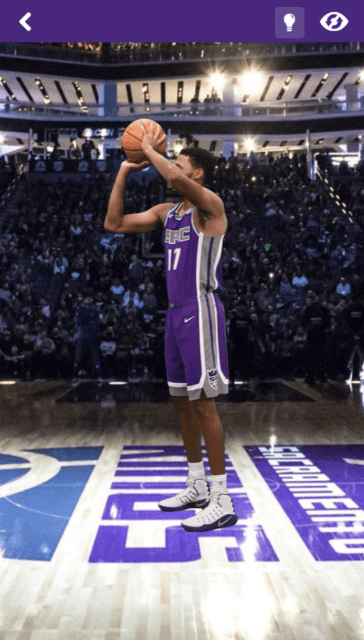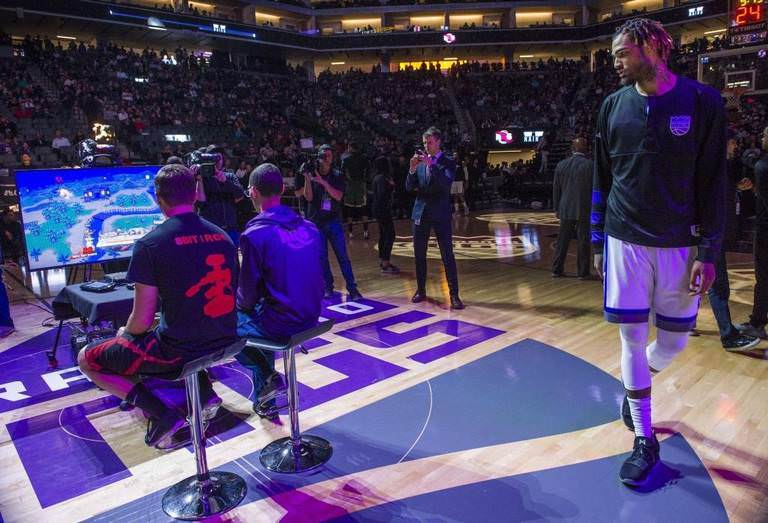The Sacramento Kings announced another first in the NBA. The team partnered with Nike and developer Zappar on Tuesday to add an augmented reality feature in its Appy Award-winning Kings + Golden 1 Center app that brings the team’s new Nike Icon uniform to life.
Fans will be able to interact with seven-year NBA veteran and Kings shooting guard Garrett Temple, who wears the new uniforms for the first time and elaborates on the new features of the team’s on-court look.
Ryan Montoya, the Kings’ chief technology officer, told AListDaily that fans can customize their own jersey with their name and number, virtually “frame” and “hang” the new look on their wall, and photograph themselves with Temple, too.
“The Kings’ culture of innovation continues to build as Nike, the most innovative and creative sports apparel company in the world, becomes the official on-court apparel provider for the NBA,” Montoya said. “This is a preview of what’s possible when teams collaborate with the NBA and brands like Nike. When we learned about the new jerseys we wanted to have the best way to launch these early with our fans. AR achieves objectives. Whether a kid lives in South Sacramento or South Asia, they can see it in real life immediately. Fans can also go in-depth to see what the differences are compared to the old jerseys.”

The new Nike purple Icon uniforms and white uniforms will be available for purchase this fall, making the AR experience the only way fan can enjoy the jersey and embedded technology until the beginning of the season.
Montoya said the Kings first embraced AR four years ago when the team opened its Experience Center for Golden 1 Center.
“Usually you’d have a physical 3D model of what the stadium will look like, but we instead created an AR app so fans could come in and use an iPad and see the arena come to life,” Montoya said. “They could walk around the arena and see our aircraft hangar doors open and see the seating for basketball versus a concert.”
Over that short span of time, Montoya has seen AR technology evolve with better graphics chips and a better viewing experience.
“It’s gotten more sophisticated and easier to use,” Montoya said. “We’re excited with every new opportunity that technology like HoloLens or Oculus Rift or HTC Vive opens up for our fans. We go to all of the technology shows. We talk to people from MagicLeap. We’re excited about the future and we have specific ideas of how we want to utilize new technology for our fans.”
Montoya said that for over a decade, the Kings have been pushing the boundaries on digital innovation, welcoming fans behind the curtain for enhanced and immersive experiences through this app, as well as inside the arena. The team has been at the forefront for many of activations that an average sports fan would not anticipate a franchise to make. They were the first team to join Twitter, invest in a virtual reality company (Voke), host a Reddit “Ask Me Anything” with players, use Facebook Live to interview players, stream a game in virtual reality internationally and host a startup competition.
Andy Miller, co-owner of the Sacramento Kings, is also at the forefront of the team’s esports movement. He previously has said that his NBA franchise’s new Golden 1 Center was built for esports. Last week, the Miller-owned NRG Esports entered into Activision Blizzard’s Overwatch League.
“Andy has been involved in esports and we’ve been trying to figure out the best way to get involved,” Montoya said. “We were one of the first NBA teams to raise our hands and embrace esports as the future—not only with the NBA 2K ELeague, but with our own arena activation.”
In March, Golden 1 Center hosted a halftime esports competition with Team NRG’s Nairoby “Nairo” Quezada taking on a local gamer, Caleb Patton, who had battled his way through a 50-person “Road to the Golden 1 Center” Super Smash Bros. tournament to play in front of over 17,000 NBA fans. The five-minute competition was played at center court on the NBA’s largest 4K videoboard.
The Kings also embraced gaming by hosting a Pokémon Go meet-up at its stadium at the peak of the gaming craze last year.
“We’re excited to have an NBA 2K esports team here,” Montoya said. “We’ve been talking to a lot of players in that community, and a lot of them want to come here because of what they’ve heard or seen about the technology inside the arena.”
That technology includes over 800 wi-fi access points inside the billion-dollar arena, which has 650 miles of fiber-optic cable and 300-plus miles of copper running though its infrastructure. There’s even a 6,000-square-foot data center in the stadium, which is one reason attendees can theoretically send 500,000 Snapchats per second.
The NBA has the youngest audience across the four major sports in the US. In addition, one in seven people in the world is following the NBA on social media. This global audience is also crazy about NBA 2K, with over 34 million people playing in China alone.
“We built the arena with complete future-proof flexibility because we see Golden 1 Center as a platform with the ability to scale over time,” Montoya said. “Anyone who comes in here would love to play NBA 2K on the scoreboard or any of the other esports games. Esports was in the design and development phase of this arena. It’s the ideal location for hosting esports events, as well as concerts and other entertainment.”

